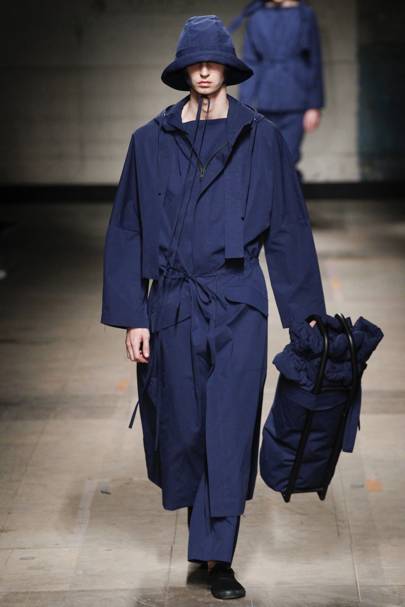
Green is, without contest, one of the most important designers working in London right now. A graduate of Central Saint Martins’ famed MA Fashion course, he established his own label in 2012 to immediate acclaim. The accolades have come quickly. He was named Emerging Menswear Designer of the Year at the 2014 British Fashion Awards; and in 2016, he ascended to British Menswear Designer of the Year. Critics love him, and so do buyers. His designs are carried at Dover Street Market, 10 Corso Como, Selfridges and Galeries Lafayette. More recently, the director Ridley Scott tapped him to design costumes for Alien: Covenant.

"I find something romantic about people having a communal way of dress,” says Green. From his earliest collections, his work has been animated by his fascination with uniforms of all sorts and how they function both practically and conceptually. “My family were all tradesmen,” Green explains. “My dad was plumber and my mother was a nurse—they were working people who wore uniforms. The whole brand is based around ideas of communal dress, and romanticising things that might not really be so obviously romantic. That idea is something that carries all the way through in every single collection."
Green’s early work explored the connections between workwear and religious garb, culminating in his famously evocative spring/summer 2015 show. One of the most universally praised shows in recent memory, a number of audience members proudly announced that it brought them to tears. Its power came from the coherence and directness of its statement - the garments were all variations on a flowing, voluminous theme, styled in bold monochrome ensembles. This is a storytelling technique central to Green’s process. “Our idea is to make everyone work as one, through the clothing," he continues. "The way that the collections are designed, they start with colour blocks on a wall—the colour story and the rhythm comes first. It’s ‘black look, cream look, black look', before we even have clothes. For autumn/winter 2015, if you look at the line-up of all 30 boys on a wall, the colours make up the picture of a flag. It’s a procession of 30 boys telling that one story."
This all-for-one impulse reveals itself in Green’s cuts and detailing, as well. By taking tailoring cues from the loose, mass-produced sizing of generic uniforms and workwear, Green’s work tends to offer wide, forgiving cuts that almost anyone can find themselves in - men and women alike. Though Green considers himself a menswear designer, more and more retailers are purchasing his clothing with women in mind. "I guess it is unisex, but it’s more almost sexless,” Green says. “I can wear a jacket with a string-belted waist and not do it up, and then we have girls on our team who tie it at the waist to pull it in so it looks more feminine. It’s a play on function, using strings and simplistic ties to warp the silhouette of a boxy, simple garment."

Green’s last three collections have focused on rejuvenating quaint, overlooked fabrics and motifs from his past - like boy scout scarves in spring/summer 2017 - and the three before that were about, as he puts it, making something out of nothing. His next collection promises another thematic shift: “We’re romanticising the present a little more now, rather than the past.”
In a time of global turmoil and instability, Green’s tender approach is especially important. “I always saw fashion as escapist,” he says. “Even in hard times, people need to have dreams and fantasies.” But escapism is not just a comforting distraction, it’s necessary work - all possible worlds begin first as fantasies.

No comments:
Post a Comment